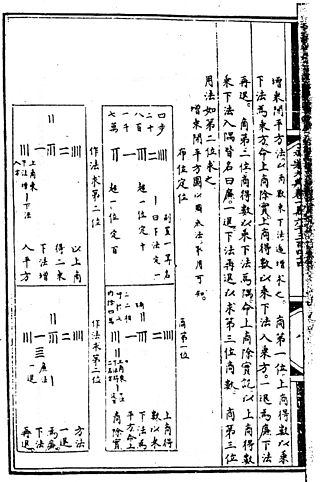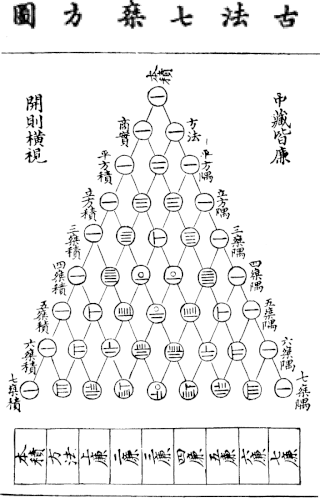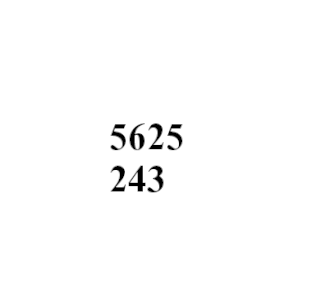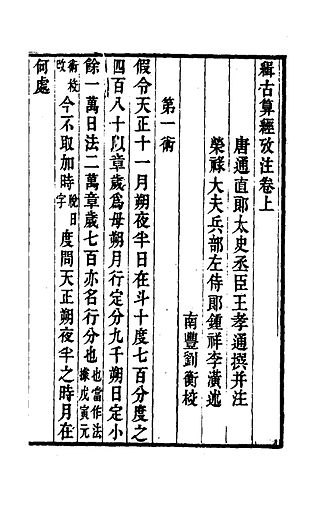
Liber Abaci is a historic 1202 Latin manuscript on arithmetic by Leonardo of Pisa, posthumously known as Fibonacci.
Liu Hui was a Chinese mathematician who published a commentary in 263 CE on Jiu Zhang Suan Shu. He was a descendant of the Marquis of Zixiang of the Eastern Han dynasty and lived in the state of Cao Wei during the Three Kingdoms period of China.

The Nine Chapters on the Mathematical Art is a Chinese mathematics book, composed by several generations of scholars from the 10th–2nd century BCE, its latest stage being from the 2nd century CE. This book is one of the earliest surviving mathematical texts from China, the first being Suan shu shu and Zhoubi Suanjing. It lays out an approach to mathematics that centres on finding the most general methods of solving problems, which may be contrasted with the approach common to ancient Greek mathematicians, who tended to deduce propositions from an initial set of axioms.
Ancient Egyptian mathematics is the mathematics that was developed and used in Ancient Egypt c. 3000 to c. 300 BCE, from the Old Kingdom of Egypt until roughly the beginning of Hellenistic Egypt. The ancient Egyptians utilized a numeral system for counting and solving written mathematical problems, often involving multiplication and fractions. Evidence for Egyptian mathematics is limited to a scarce amount of surviving sources written on papyrus. From these texts it is known that ancient Egyptians understood concepts of geometry, such as determining the surface area and volume of three-dimensional shapes useful for architectural engineering, and algebra, such as the false position method and quadratic equations.

Mathematics in China emerged independently by the 11th century BCE. The Chinese independently developed a real number system that includes significantly large and negative numbers, more than one numeral system, algebra, geometry, number theory and trigonometry.
The Hindu–Arabic numeral system is a decimal place-value numeral system that uses a zero glyph as in "205".
The Book on Numbers and Computation, or the Writings on Reckoning, is one of the earliest known Chinese mathematical treatises. It was written during the early Western Han dynasty, sometime between 202 BC and 186 BC. It was preserved among the Zhangjiashan Han bamboo texts and contains similar mathematical problems and principles found in the later Eastern Han period text of The Nine Chapters on the Mathematical Art.
Li Chunfeng was a Chinese mathematician, astronomer, historian, and politician who was born in today's Baoji, Shaanxi, during the Sui and Tang dynasties. He was first appointed to the Imperial Astronomy Bureau to help institute a calendar reform. He eventually ascended to deputy of the Imperial Astronomy Bureau and designed the Linde calendar. His father was an educated state official and also a Taoist. Li died in Chang'an in 670.

Rod calculus or rod calculation was the mechanical method of algorithmic computation with counting rods in China from the Warring States to Ming dynasty before the counting rods were increasingly replaced by the more convenient and faster abacus. Rod calculus played a key role in the development of Chinese mathematics to its height in Song Dynasty and Yuan Dynasty, culminating in the invention of polynomial equations of up to four unknowns in the work of Zhu Shijie.

Haidao Suanjing was written by the Chinese mathematician Liu Hui of the Three Kingdoms era (220–280) as an extension of chapter 9 of The Nine Chapters on the Mathematical Art. During the Tang Dynasty, this appendix was taken out from The Nine Chapters on the Mathematical Art as a separate book, titled Haidao suanjing (Sea Island Mathematical Manual), named after problem No 1 "Looking at a sea island." In the time of the early Tang dynasty, Haidao Suanjing was selected into one of The Ten Computational Canons as the official mathematical texts for imperial examinations in mathematics.
Wang Xiaotong (王孝通), also known as Wang Hs'iao-t'ung, was a Chinese mathematician, calendarist, politician, and writer of the early Tang dynasty. He is famous as the author of the Jigu Suanjing one of the Ten Computational Canons.
This is a timeline of pure and applied mathematics history. It is divided here into three stages, corresponding to stages in the development of mathematical notation: a "rhetorical" stage in which calculations are described purely by words, a "syncopated" stage in which quantities and common algebraic operations are beginning to be represented by symbolic abbreviations, and finally a "symbolic" stage, in which comprehensive notational systems for formulas are the norm.

Counting rods are small bars, typically 3–14 cm long, that were used by mathematicians for calculation in ancient East Asia. They are placed either horizontally or vertically to represent any integer or rational number.

Principles of Hindu Reckoning is a mathematics book written by the 10th- and 11th-century Persian mathematician Kushyar ibn Labban. It is the second-oldest book extant in Arabic about Hindu arithmetic using Hindu-Arabic numerals, preceded by Kibab al-Fusul fi al-Hisub al-Hindi by Abul al-Hassan Ahmad ibn Ibrahim al-Uglidis, written in 952.

Jigu suanjing was the work of early Tang dynasty calendarist and mathematician Wang Xiaotong, written some time before the year 626, when he presented his work to the Emperor. Jigu Suanjing was included as one of the requisite texts for Imperial examination; the amount of time required for the study of Jigu Suanjing was three years, the same as for The Nine Chapters on the Mathematical Art and Haidao Suanjing.

The Ten Computational Canons was a collection of ten Chinese mathematical works, compiled by early Tang dynasty mathematician Li Chunfeng (602–670), as the official mathematical texts for imperial examinations in mathematics.

Sunzi Suanjing was a mathematical treatise written during 3rd to 5th centuries AD which was listed as one of the Ten Computational Canons during the Tang dynasty. The specific identity of its author Sunzi is still unknown but he lived much later than his namesake Sun Tzu, author of The Art of War. From the textual evidence in the book, some scholars concluded that the work was completed during the Southern and Northern Dynasties. Besides describing arithmetic methods and investigating Diophantine equations, the treatise touches upon astronomy and attempts to develop a calendar.
The Hundred Fowls Problem is a problem first discussed in the fifth century CE Chinese mathematics text Zhang Qiujian suanjing, a book of mathematical problems written by Zhang Qiujian. It is one of the best known examples of indeterminate problems in the early history of mathematics. The problem appears as the final problem in Zhang Qiujian suanjing. However, the problem and its variants have appeared in the medieval mathematical literature of India, Europe and the Arab world.
Wucao Suanjing is one of the books in the collection of mathematical texts assembled by Li Chunfeng and collectively referred to as The Ten Computational Canons by later writers. The text was designed for the teaching of those entering the five government departments of agriculture, war, accounts, granary and treasury. There is a chapter relating to each one of these departments. The text contains some formulas to find the areas of different shapes of fields. Though the formulas give approximately correct answers, they are actually incorrect. This incorrectness motivated further mathematical work. The mathematics involved does not go much beyond the processes of multiplication and division.
Xiahou Yang Suanjing is a mathematical treatise attributed to the fifth century CE Chinese mathematician Xiahou Yang. However, some historians are of the opinion that Xiahou Yang Suanjing was not written by Xiahou Yang. It is one of the books in The Ten Computational Canons, a collection of mathematical texts assembled by Li Chunfeng and used as the official mathematical for the imperial examinations.










